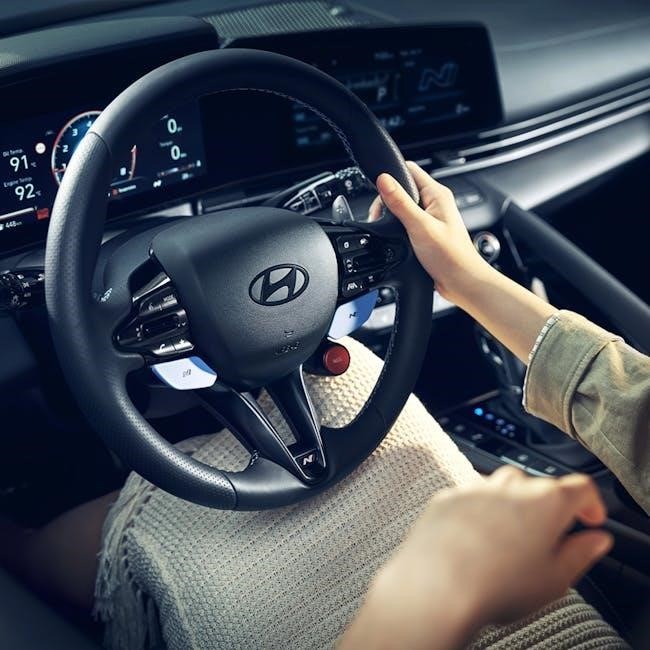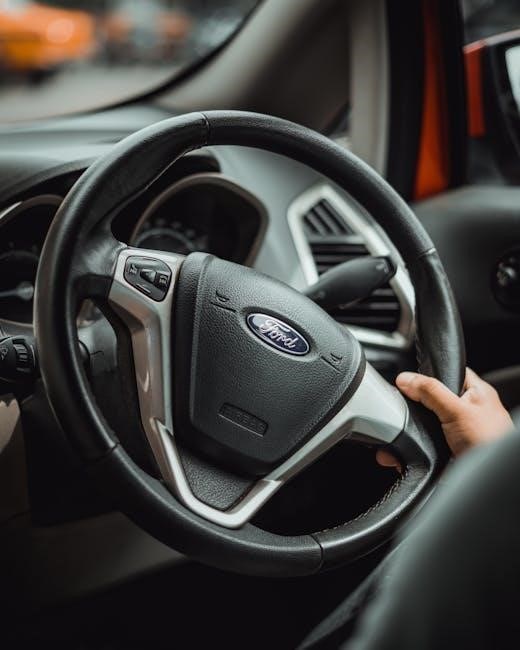Engaging a 4-wheel drive manually requires careful preparation and understanding of your vehicle’s system. Familiarize yourself with the transfer case, locking hubs, and proper gear selection for safe and effective operation.
Overview of 4-Wheel Drive Systems
A 4-wheel drive (4WD) system is designed to distribute power to all four wheels of a vehicle, enhancing traction and control in challenging conditions. These systems typically include a transfer case, which manages power distribution between the front and rear axles, and locking hubs, which engage the front wheels when 4WD is activated. Modern vehicles often feature either part-time or full-time 4WD systems, with modes like high range (4H) for higher speeds and low range (4L) for low-speed, high-torque situations. Proper engagement involves understanding these components and their functions, ensuring the vehicle is prepared for various terrains. Regular maintenance, such as checking hub operation and transfer case fluid, is essential for system reliability. By mastering these elements, drivers can effectively utilize their 4WD system for off-road adventures or inclement weather conditions.
Proper engagement of 4-wheel drive is crucial for maintaining control and preventing damage to your vehicle. Improper engagement can lead to mechanical failures, such as damaged transfer cases or axles, which are costly to repair. Additionally, failing to engage 4WD when needed can result in loss of traction, making it difficult to navigate challenging terrains like snow, mud, or steep inclines. Proper engagement ensures optimal performance, improves safety, and reduces the risk of accidents. It also preserves the longevity of your vehicle’s drivetrain by distributing power evenly and efficiently. Always follow the manufacturer’s guidelines and take the time to engage 4WD correctly to maximize its benefits and minimize potential risks. Remember, understanding and adhering to the proper engagement procedures is essential for both on-road and off-road driving scenarios.Importance of Proper Engagement

Pre-Engagement Checks and Preparation
Before engaging 4WD, ensure your vehicle is ready by checking speed, gear selection, and hub locks. Familiarize yourself with the system to avoid mechanical issues.
Understanding Your Vehicle’s 4WD System
Understanding your vehicle’s 4WD system is crucial for proper engagement. Most systems feature a transfer case that distributes power between front and rear axles. Some vehicles use automatic hubs, while others require manual locking. Refer to your owner’s manual to identify whether your system is part-time or full-time. Part-time 4WD should only be used in low-traction conditions, while full-time systems can be used on various surfaces. Familiarize yourself with the controls, such as the transfer case lever or buttons, and know the difference between high range (4H) and low range (4L) modes. Proper knowledge ensures safe and effective use, preventing potential damage to the drivetrain. Always follow the manufacturer’s guidelines for engaging and disengaging 4WD to maintain optimal performance and avoid mechanical issues.
Checking Vehicle Speed and Conditions
Before engaging 4WD, ensure your vehicle speed is appropriate, typically below 40 mph, to avoid potential damage. Assess road conditions like mud, snow, or sand, and terrain difficulty. Stop or reduce speed significantly if necessary. Check for obstacles and ensure stable ground to maintain control. Avoid engaging 4WD on dry pavement to prevent drivetrain strain. Verify dashboard indicators confirm proper engagement and wheel synchronization. This preparation ensures smooth and safe 4WD activation.
Ensuring Proper Gear Selection
Proper gear selection is crucial when engaging 4-wheel drive manually. Shift your vehicle into neutral or park to ensure the transmission is disengaged, allowing the transfer case to function correctly. For high-range 4WD, maintain moderate speeds, while low-range is reserved for extreme conditions like steep inclines or heavy towing. Always refer to your vehicle’s manual to confirm the correct gear for the situation. Incorrect gear selection can lead to mechanical stress or system damage. Ensuring the right gear is engaged enhances control, traction, and safety, especially in challenging off-road scenarios. This step is vital for optimal performance and longevity of your 4WD system.

The Engagement Process
The engagement process involves stopping safely, shifting into neutral or park, and using the transfer case lever to activate 4WD. Ensure smooth transitioning for optimal traction and control.
Stopping the Vehicle Safely
Stopping the vehicle safely is the first crucial step in engaging 4-wheel drive. Find a flat, stable surface and bring your vehicle to a complete stop using the brakes gently. Ensure the area is clear of obstacles and traffic to avoid accidents. Turn off any distractions like the radio to maintain focus. With the vehicle stationary, you can proceed to shift into neutral or park, depending on your vehicle’s requirements. This step is essential because engaging 4WD while moving can damage the drivetrain or lead to loss of control. Always refer to your vehicle’s manual for specific instructions, as different models may have varying procedures for safe engagement. Once stopped, you are ready to engage the 4WD system confidently and safely.
Shifting into Neutral or Park
Shifting into neutral or park is a critical step when engaging 4-wheel drive manually. Once the vehicle is safely stopped, move the transmission into neutral for manual transmissions or park for automatics. This ensures the engine and drivetrain are disengaged, preventing any unintended movement or strain on the system. Failing to do so may result in damage to the transfer case or other components. After shifting, check that the parking brake is engaged to maintain stability. This step is especially important in automatic vehicles, where “park” locks the transmission, ensuring no accidental gear engagement occurs. Always follow your vehicle’s manual for specific instructions, as some models may have additional requirements for engaging 4WD. Properly shifting into neutral or park sets the stage for a smooth and safe transition into four-wheel drive mode. This step should never be skipped to avoid potential mechanical issues.
Using the Transfer Case Lever
The transfer case lever is a vital component in engaging 4-wheel drive manually. After stopping the vehicle and shifting into neutral or park, locate the transfer case lever, typically found on the center console or near the gearshift. For high range 4WD (4H), pull the lever down or towards you. For low range 4WD (4L), you may need to push the lever in and then pull it to engage. Ensure the vehicle is stable and on level ground before engaging. You should feel or hear a mechanical click indicating the 4WD system has activated. Avoid forcing the lever, as this could damage the transfer case. Always confirm engagement by checking the dashboard indicators or listening for the characteristic sound of the system activating. If your vehicle has an electronic transfer case, the process may involve pressing a button instead of using a lever. Consult your vehicle’s manual for specific instructions, as procedures can vary. Proper use of the transfer case lever ensures smooth and effective engagement of the 4WD system.
Engaging the Locking Hubs
Engaging the locking hubs is a critical step in activating the 4-wheel drive system. Start by ensuring the vehicle is stationary or moving at a low speed. Locate the locking hubs on the front wheels and rotate them from the “FREE” to the “LOCK” position. This action prepares the front wheels to receive power from the drivetrain. For vehicles with manual hubs, this step must be done before engaging the transfer case lever. On some models, the hubs may engage automatically when the transfer case is activated. Always check your vehicle’s manual for specific instructions, as the process can vary. Properly engaging the locking hubs ensures that power is distributed evenly to all four wheels, enhancing traction and control in challenging driving conditions. Failure to engage the hubs correctly can result in reduced performance or potential damage to the 4WD system.

Understanding 4WD Modes
4WD systems typically offer two primary modes: High Range (4H) for higher speeds and light terrain, and Low Range (4L) for maximum torque and steep inclines or heavy loads.
High Range 4WD (4H)
The High Range 4WD (4H) mode is designed for driving at higher speeds on light to moderate terrain. It provides improved traction compared to two-wheel drive without sacrificing speed. This mode is ideal for gravel roads, muddy trails, or snowy conditions where extra grip is needed but high torque isn’t necessary. When engaging 4H, ensure the vehicle is moving at a low speed, typically under 40 mph, and shift into neutral or park before activating the transfer case. This mode allows for smoother transitions and maintains better fuel efficiency than Low Range. Always refer to your vehicle’s manual to confirm the proper procedure for engaging 4H, as methods may vary between models. Proper use of 4H enhances control and stability, making it a versatile option for various off-road scenarios.
Low Range 4WD (4L)
Low Range 4WD (4L) is designed for extreme off-road conditions where maximum torque and control are essential. This mode is ideal for steep inclines, deep mud, or rocky terrain, as it provides a significant reduction in gear ratio, delivering more power to the wheels. To engage 4L, ensure the vehicle is stationary or moving at a very slow speed. Shift into neutral or park, then activate the transfer case lever to select 4L. Some systems may require additional steps, such as engaging the locking hubs manually. Always refer to your vehicle’s manual for specific instructions. 4L should not be used at high speeds, as it can damage the drivetrain or lead to loss of control. This mode enhances crawling ability and stability in challenging environments, making it a critical feature for serious off-road enthusiasts. Proper use of 4L ensures safety and effectiveness in demanding situations.
When to Use Each Mode
Choosing the right 4WD mode depends on driving conditions and terrain. 4H (High Range) is suitable for light off-road scenarios, such as gravel or snowy roads, where additional traction is needed without extreme speed reduction. It allows for higher speeds while maintaining stability. 4L (Low Range) is reserved for challenging environments like steep hills, deep mud, or rocky trails, where maximum torque and control are necessary. This mode should be used at low speeds to prevent drivetrain damage. Switching between modes requires the vehicle to be stationary or moving slowly, often in neutral or park. Always refer to your vehicle’s manual for specific instructions, as improper mode selection can lead to mechanical issues. Understanding when to use each mode ensures optimal performance, safety, and extends the lifespan of your 4WD system. Proper mode selection is crucial for mastering various off-road conditions effectively.

Troubleshooting Common Issues
Common 4WD engagement issues include faulty transfer cases, broken hub locks, or wiring problems. Check hubs, fluids, and fuses; consult your manual for diagnostic steps to resolve issues effectively.
What to Do If 4WD Doesn’t Engage
If your 4WD fails to engage, start by checking the basics. Ensure the vehicle is in neutral or park, as most systems require this to activate. Next, inspect the transfer case lever or knob for proper alignment and smooth movement. If you’re using manual locking hubs, verify they’re securely engaged in the “lock” position. Check the dashboard for warning lights, which may indicate system malfunctions. Consult your owner’s manual for specific diagnostic steps, as procedures can vary by model. Additionally, examine the wiring and fuses related to the 4WD system for any damage or corrosion. If issues persist, consider seeking assistance from a professional mechanic experienced with 4WD systems. Always prioritize safety and avoid driving in conditions that require 4WD until the system is fully functional. Regular maintenance can help prevent such issues, so keep your vehicle serviced.
Disengaging 4WD Properly
To disengage 4WD safely, start by stopping the vehicle completely and shifting into neutral or park, depending on your vehicle’s requirements. This ensures the system can transition smoothly without damage. Next, use the transfer case lever to return to two-wheel drive mode. For manual locking hubs, switch them back to the “free” position to disengage the front wheels. Avoid disengaging 4WD while moving, as this can cause mechanical stress and potential damage to the drivetrain. If your vehicle has an automatic system, consult the owner’s manual for specific instructions. After disengaging, check your dashboard to ensure no warning lights remain illuminated. Regularly testing your 4WD system ensures it functions correctly when needed. Proper disengagement helps maintain your vehicle’s performance and longevity. Always follow the manufacturer’s guidelines for your specific 4WD system to avoid complications.

Safety Tips and Best Practices
Always follow manufacturer guidelines when engaging 4WD. Ensure proper preparation and vehicle checks. Avoid sudden movements in 4WD mode to maintain control. Regular maintenance is essential for optimal performance.
Driving Safely in 4WD Mode
Driving in 4WD mode requires cautious handling to ensure stability and control. Reduce your speed, especially on uneven terrain, to avoid skidding or losing traction. Always maintain a firm grip on the steering wheel and be prepared for changes in vehicle behavior. Avoid sudden acceleration or sharp turns, as these can destabilize the vehicle. Use low range for steep inclines or heavy loads to maintain torque and control. Keep an eye on your surroundings, watching for obstacles like rocks or water that could pose a hazard. Remember, 4WD enhances traction but does not improve braking distance, so maintain a safe distance from other vehicles. Regularly check your tire pressure, as proper inflation is crucial for effective 4WD performance. By following these guidelines, you can ensure a safer and more enjoyable off-road experience.
Maintaining Your 4WD System
Proper maintenance of your 4WD system is essential to ensure its reliability and performance. Regularly check the transfer case and differential fluids to maintain optimal lubrication and prevent overheating. Inspect the driveshaft, axles, and universal joints for wear or damage, as these components are critical to transferring power to all wheels. Lubricate the locking hubs and ensure they are free from debris to facilitate smooth engagement. Additionally, test your 4WD system periodically on a flat, open surface to confirm it engages and disengages properly. Address any unusual noises or vibrations immediately, as they may indicate underlying issues. Finally, refer to your vehicle’s manual for specific maintenance schedules and guidelines tailored to your 4WD system. By staying proactive, you can extend the lifespan of your 4WD components and ensure they function efficiently when needed. Regular upkeep is key to avoiding costly repairs and maintaining off-road capability.
Mastering the manual engagement of your 4-wheel drive system is a valuable skill for any off-road enthusiast. Understanding the proper steps, from preparation to execution, ensures safe and effective use of your vehicle’s capabilities. Always remember to familiarize yourself with your vehicle’s specific 4WD system, as procedures can vary. Regular maintenance and adherence to safety guidelines are crucial to maintaining performance and preventing damage. By following the outlined steps and best practices, you can confidently engage your 4WD system, whether navigating challenging terrain or towing heavy loads. Remember to stay alert, avoid distractions, and use the appropriate mode for the conditions. With practice and adherence to these principles, you’ll optimize your vehicle’s performance and enhance your off-road adventures. Safe driving and happy trails await those who master the art of manual 4WD engagement.

